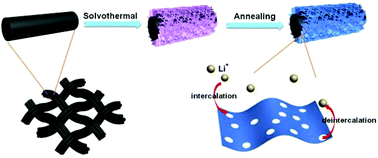Hierarchical porous NiCo2O4 nanosheet arrays directly grown on carbon cloth with superior lithium storage performance†
Abstract
Binary metal oxides have been explored as advanced candidates in lithium-ion battery (LIB) anodes due to their high specific capacity. Herein, the hierarchical structures of porous NiCo2O4 nanosheets directly grown on a conductive carbon cloth substrate (3D NCO-PSA/CC) were obtained by a facile in situ synthetic strategy. When applied as a binder-free LIB anode, it exhibited satisfactory performance with a high discharge capacity (a first discharge capacity of 2090.8 mA h g−1 and a stable capacity of 1687.6 mA h g−1 at 500 mA g−1), superior rate capacity (discharge capacity of 375.5 mA h g−1 at 6000 mA g−1) and excellent reversibility (coulombic efficiency of approximately 100%). The outstanding performances should be attributed to the 3D porous structures, nanosheets and good conductivity of NCO-PSA/CC that could not only ensure the rapid transport of Li+ ions and electrons but also remit the huge volume change during lithiation/delithiation processes. Undoubtedly, the present facile and effective strategy can be extended to other binary metal–oxide materials for use as high-performance energy storage and conversion devices.



 Please wait while we load your content...
Please wait while we load your content...